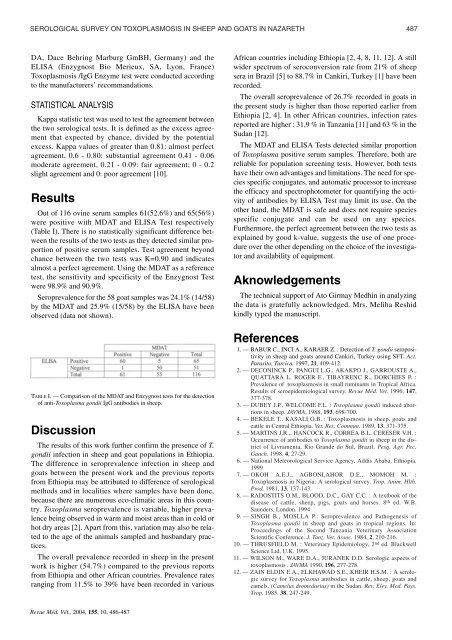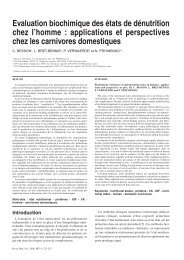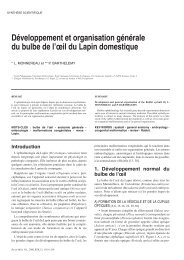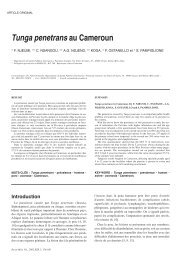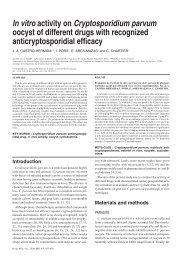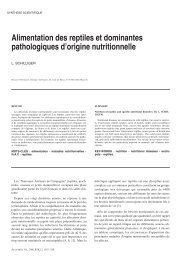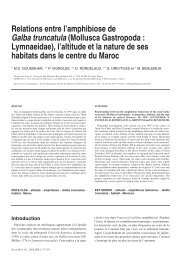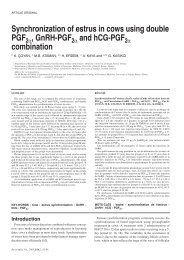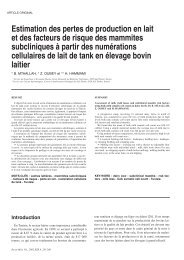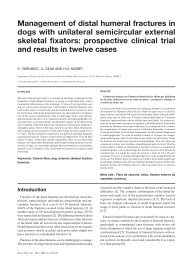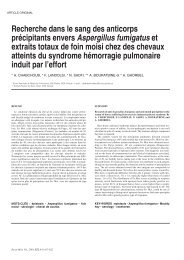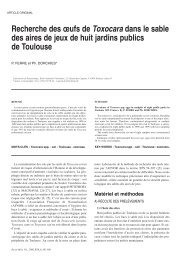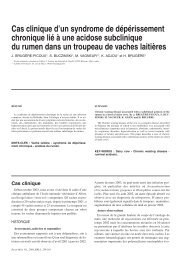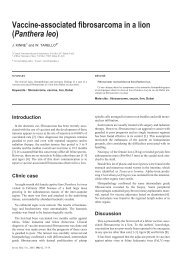Serological survey on Toxoplasmosis in sheep and goats in ...
Serological survey on Toxoplasmosis in sheep and goats in ...
Serological survey on Toxoplasmosis in sheep and goats in ...
Create successful ePaper yourself
Turn your PDF publications into a flip-book with our unique Google optimized e-Paper software.
SEROLOGICAL SURVEY ON TOXOPLASMOSIS IN SHEEP AND GOATS IN NAZARETH 487<br />
DA, Dace Behr<strong>in</strong>g Marburg GmBH, Germany) <strong>and</strong> the<br />
ELISA (Enzygnost Bio Merieux, SA, Ly<strong>on</strong>, France)<br />
<strong>Toxoplasmosis</strong> /IgG Enzyme test were c<strong>on</strong>ducted accord<strong>in</strong>g<br />
to the manufacturers’ recomm<strong>and</strong>ati<strong>on</strong>s.<br />
STATISTICAL ANALYSIS<br />
Kappa statistic test was used to test the agreement between<br />
the two serological tests. It is def<strong>in</strong>ed as the excess agreement<br />
that expected by chance, divided by the potential<br />
excess. Kappa values of greater than 0.81: almost perfect<br />
agreement, 0.6 - 0.80: substantial agreement 0.41 - 0.06<br />
moderate agreement, 0.21 - 0.09: fair agreement; 0 - 0.2<br />
slight agreement <strong>and</strong> 0: poor agreement [10].<br />
Results<br />
Out of 116 ov<strong>in</strong>e serum samples 61(52.6%) <strong>and</strong> 65(56%)<br />
were positive with MDAT <strong>and</strong> ELISA Test respectively<br />
(Table I). There is no statistically significant difference between<br />
the results of the two tests as they detected similar proporti<strong>on</strong><br />
of positive serum samples. Test agreement bey<strong>on</strong>d<br />
chance between the two tests was K=0.90 <strong>and</strong> <strong>in</strong>dicates<br />
almost a perfect agreement. Us<strong>in</strong>g the MDAT as a reference<br />
test, the sensitivity <strong>and</strong> specificity of the Enzygnost Test<br />
were 98.9% <strong>and</strong> 90.9%.<br />
Seroprevalence for the 58 goat samples was 24.1% (14/58)<br />
by the MDAT <strong>and</strong> 25.9% (15/58) by the ELISA have been<br />
observed (data not shown).<br />
TABLE I. — Comparis<strong>on</strong> of the MDAT <strong>and</strong> Enzygnost tests for the detecti<strong>on</strong><br />
of anti-Toxoplasma g<strong>on</strong>dii IgG antibodies <strong>in</strong> <strong>sheep</strong>.<br />
Discussi<strong>on</strong><br />
The results of this work further c<strong>on</strong>firm the presence of T.<br />
g<strong>on</strong>dii <strong>in</strong>fecti<strong>on</strong> <strong>in</strong> <strong>sheep</strong> <strong>and</strong> goat populati<strong>on</strong>s <strong>in</strong> Ethiopia.<br />
The difference <strong>in</strong> seroprevalence <strong>in</strong>fecti<strong>on</strong> <strong>in</strong> <strong>sheep</strong> <strong>and</strong><br />
<strong>goats</strong> between the present work <strong>and</strong> the previous reports<br />
from Ethiopia may be attributed to difference of serological<br />
methods <strong>and</strong> <strong>in</strong> localities where samples have been d<strong>on</strong>e,<br />
because there are numerous eco-climatic areas <strong>in</strong> this country.<br />
Toxoplasma seroprevalence is variable, higher prevalence<br />
be<strong>in</strong>g observed <strong>in</strong> warm <strong>and</strong> moist areas than <strong>in</strong> cold or<br />
hot dry areas [2]. Apart from this, variati<strong>on</strong> may also be related<br />
to the age of the animals sampled <strong>and</strong> husb<strong>and</strong>ary practices.<br />
The overall prevalence recorded <strong>in</strong> <strong>sheep</strong> <strong>in</strong> the present<br />
work is higher (54.7%) compared to the previous reports<br />
from Ethiopia <strong>and</strong> other African countries. Prevalence rates<br />
rang<strong>in</strong>g from 11.5% to 39% have been recorded <strong>in</strong> various<br />
African countries <strong>in</strong>clud<strong>in</strong>g Ethiopia [2, 4, 8, 11, 12]. A still<br />
wider spectrum of seroc<strong>on</strong>versi<strong>on</strong> rate from 21% of <strong>sheep</strong><br />
sera <strong>in</strong> Brazil [5] to 88.7% <strong>in</strong> Cankiri, Turkey [1] have been<br />
recorded.<br />
The overall seroprevalence of 26.7% recorded <strong>in</strong> <strong>goats</strong> <strong>in</strong><br />
the present study is higher than those reported earlier from<br />
Ethiopia [2, 4]. In other African countries, <strong>in</strong>fecti<strong>on</strong> rates<br />
reported are higher : 31,9 % <strong>in</strong> Tanzania [11] <strong>and</strong> 63 % <strong>in</strong> the<br />
Sudan [12].<br />
The MDAT <strong>and</strong> ELISA Tests detected similar proporti<strong>on</strong><br />
of Toxoplasma positive serum samples. Therefore, both are<br />
reliable for populati<strong>on</strong> screen<strong>in</strong>g tests. However, both tests<br />
have their own advantages <strong>and</strong> limitati<strong>on</strong>s. The need for species<br />
specific c<strong>on</strong>jugates, <strong>and</strong> automatic processor to <strong>in</strong>crease<br />
the efficacy <strong>and</strong> spectrophotometer for quantify<strong>in</strong>g the activity<br />
of antibodies by ELISA Test may limit its use. On the<br />
other h<strong>and</strong>, the MDAT is safe <strong>and</strong> does not require species<br />
specific c<strong>on</strong>jugate <strong>and</strong> can be used <strong>on</strong> any species.<br />
Furthermore, the perfect agreement between the two tests as<br />
expla<strong>in</strong>ed by good k-value, suggests the use of <strong>on</strong>e procedure<br />
over the other depend<strong>in</strong>g <strong>on</strong> the choice of the <strong>in</strong>vestigator<br />
<strong>and</strong> availability of equipment.<br />
Aknowledgements<br />
The technical support of Ato Girmay Medh<strong>in</strong> <strong>in</strong> analyz<strong>in</strong>g<br />
the data is gratefully acknowledged. Mrs. Meliha Reshid<br />
k<strong>in</strong>dly typed the manuscript.<br />
References<br />
1. — BABUR C., INCI A., KARAER Z. : Detecti<strong>on</strong> of T. g<strong>on</strong>dii seropositivity<br />
<strong>in</strong> <strong>sheep</strong> <strong>and</strong> <strong>goats</strong> around Cankiri, Turkey us<strong>in</strong>g SFT. Act.<br />
Parasito. Turcica. 1997, 21, 409-412.<br />
2. — DECONINCK P., PANGUI L.G., AKAKPO J., GARROUSTE A.,<br />
QUATTARA L. ROGER F., TIBAYRENC R., DORCHIES P. :<br />
Prevalence of toxoplasmosis <strong>in</strong> small rum<strong>in</strong>ants <strong>in</strong> Tropical Africa.<br />
Results of seroepidemiological <str<strong>on</strong>g>survey</str<strong>on</strong>g>. Revue Méd. Vet. 1996, 147,<br />
377-378.<br />
3. — DUBEY J.P., WELCOME F.L. : Toxoplasma g<strong>on</strong>dii <strong>in</strong>duced aborti<strong>on</strong>s<br />
<strong>in</strong> <strong>sheep</strong>. JAVMA, 1988, 193, 698-700.<br />
4. — BEKELE T., KASALI O.B. : <strong>Toxoplasmosis</strong> <strong>in</strong> <strong>sheep</strong>, <strong>goats</strong> <strong>and</strong><br />
cattle <strong>in</strong> Central Ethiopia. Vet. Res. Commun. 1989, 13, 371-375.<br />
5. — MARTINS J.R.,, HANCOCK R., CORREA B.L, CERESER V.H. :<br />
Occurrence of antibodies to Toxoplasma g<strong>on</strong>dii <strong>in</strong> <strong>sheep</strong> <strong>in</strong> the district<br />
of Livramenta, Rio Gr<strong>and</strong>e do Sul, Brazil. Pesq. Agr. Pec.<br />
Gauch. 1998. 4, 27-29.<br />
6. — Nati<strong>on</strong>al Meteorological Service Agency, Addis Ababa, Ethiopia.<br />
1999<br />
7. — OKOH A.E.J., AGBONLAHOR D.E., MOMOH M. :<br />
<strong>Toxoplasmosis</strong> <strong>in</strong> Nigeria: A serological <str<strong>on</strong>g>survey</str<strong>on</strong>g>. Trop. Anim. Hlth.<br />
Prod. 1981, 13, 137-143.<br />
8. — RADOSTITS O.M., BLOOD, D.C., GAY C.C. : A textbook of the<br />
disease of cattle, <strong>sheep</strong>, pigs, <strong>goats</strong> <strong>and</strong> horses. 8 th ed. W.B.<br />
Saunders, L<strong>on</strong>d<strong>on</strong>. 1994<br />
9. — SINGH B., MOSLLA P.: Seroprevalence <strong>and</strong> Pathogenesis of<br />
Toxoplasma g<strong>on</strong>dii <strong>in</strong> <strong>sheep</strong> <strong>and</strong> <strong>goats</strong> <strong>in</strong> tropical regi<strong>on</strong>s. In:<br />
Proceed<strong>in</strong>gs of the Sec<strong>on</strong>d Tanzania Veter<strong>in</strong>ary Associati<strong>on</strong><br />
Scientific C<strong>on</strong>ference. J. Tanz. Vet. Assoc. 1984, 2, 210-216.<br />
10. — THRUSFIELD M. : Veter<strong>in</strong>ary Epidemiology, 2 nd ed. Blackwell<br />
Science Ltd. U.K. 1995.<br />
11. —WILSON M., WARE D.A., JURANEK D.D. Serologic aspects of<br />
toxoplasmosis . JAVMA 1990, 196, 277-278.<br />
12. — ZAIN ELDIN E.A., ELKHAWAD S.E.,.KHEIR H.S.M. : A serologic<br />
<str<strong>on</strong>g>survey</str<strong>on</strong>g> for Toxoplasma antibodies <strong>in</strong> cattle, <strong>sheep</strong>, <strong>goats</strong> <strong>and</strong><br />
camels. (Camelus dromedarius) <strong>in</strong> the Sudan. Rev. Elev. Med. Pays.<br />
Trop. 1985. 38, 247-249.<br />
Revue Méd. Vét., 2004, 155, 10, 486-487


